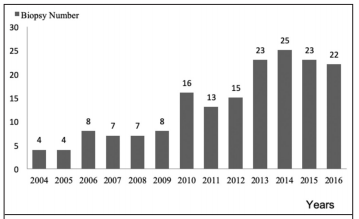Objective: This study aimed to assess the histopathological diagnosis of pediatric renal biopsies performed at the tertiary referral center in the city and to compare the ultrasound (USG) -guided biopsy and percutaneous renal needle biopsy (PRNB) in terms of safety.
Materials and Methods: All pediatric cases who underwent percutaneous renal biopsy at the center from January 2004 to December 2016 were reviewed retrospectively. The biopsy methods were compared in terms of complications.
Results: A total of 171 pediatric renal biopsies in 151 patients were included in the study. The most common renal pathology was primary glomerular disease (47.37%), and membranoproliferative glomerulonephritis (MPGN) was the most common glomerular pathology (19.30%). Systemic diseases (20.47%), tubulointerstitial diseases (8.77%), hereditary and congenital diseases (5.26%), chronic pyelonephritis (5.26%), and malignancy (0.58%) followed MPGN, respectively. The number of USG-guided biopsies performed by different radiologists was 79 (46.20%), and the number of PRNB performed by an experienced nephrologist was 92 (53.80%). No statistically significant difference was found between the two methods in terms of complications (p=0.50).
Conclusions: The MPGN was the most common pathology in the center. The PRNB is a safe diagnostic method for pediatric renal diseases when performed by an experienced nephrologist.
Cite this article as: Sürmeli Döven S, Delibaş A, Gürses İ, Esen K, Yuyucu Karabulut Y, Coşkun Yılmaz B, et al. Membranoproliferative Glomerulonephritis: The Most Common Pediatric Renal Pathology at a Tertiary Center in Turkey. Turk J Nephrol 2019; 28(4): 263-8.

.png)


.png)

.png)
